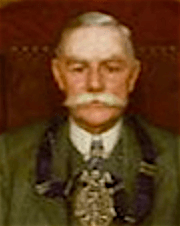
Mervyn Edmund Macartney was born the son of a doctor in London, England on 16 September 1853. He spent his youth in Co. Armagh, Northern Ireland, and was educated privately before studying at Lincoln College, Oxford (1873-77). He was then articled to Richard Norman Shaw (1831-1912) in 1877. After travelling in France, Italy and Germany, Macartney established his own independent practice in London in 1882. [Note: the date is given as 1877 in his entry in Who's Who in Architecture 1914]
Macartney was elected a Fellow of the Royal Institute of British Architects (FRIBA) in 1889 and was a Fellow of the Society of Architects (FSA) and an Hon. Corresponding Member of the American Institute of Architects (AIA) He was Surveyor to the Fabric of St. Paul's Cathedral in London from 1906 to 1931, and Consulting Architect to Durham Cathedral.
In addition to his work as an architect, Macartney also designed furniture, and in October 1890, together with William Lethaby, Ernest Gimson, Reginald Blomfield and Sidney Barnsley, was co-founder of the short-lived furniture firm Kenton & Co., which had workshops in Kenton Street, Bloomsbury, London. Undercapitalised, the venture was disbanded in 1892. A mahogany sideboard designed by Macartney for Morris & Co. is illustrated in 'The Studio Yearbook of Decorative Art' 1909 (p.17), and an Italian walnut cabinet designed by him for Morris & Co. is illustrated in 'The Studio Yearbook of Decorative Art' 1910 (p.89). Two photographs of a Serpentine macassar ebony secretaire designed by him for the Barnard's Inn in Holborn, London, and shown in an exhibition of work by Kenton & Co. in 1891 are also illustrated in 'Art and Crafts Furniture' by John Andrews (Woodbridge, Suffolk, England: Antique Collectors' Club, 2005 pp.94, 95).
Macartney was a founding member of the Art Workers Guild (AWG) in 1884 and was a Master of the AWG in 1899. He was also one of the founders of the Arts and Crafts Exhibition Society in 1887 and participated in their 1st (1888), 3rd (1890), 4th (1893), 6th (1899), 9th (1910), and 11th (1916) exhibitions in London. He also exhibited at the Royal Academy in London and at the Royal Glasgow Institute of the Fine Arts..
He was editor of the 'Architectural Review' from 1906 to 1920. He was the author of 'Later Renaissance Architecture in England' (London: B.T. Batsford, 1901), 'English Houses & Gardens in the 17th & 18th Centuries' (London: B.T. Batsford, 1908), and 'The Practical Exemplar of Architecture' (London: The Architectural Press, 7 series, 1908-27). He exhibited at the Royal Academy in London and the Glasgow Institute of the Fine Arts between 1882 and 1927.
Macartney was knighted for services to architecture in 1930. He lived in London, where he died on 28 October 1932.
Architectural projects by Macartney included 167 Queen's Gate, Kensington, London (1889-90); Costa Hill, Mainland, Orkney, Scotland (1890); Sandhills, near Bletchingley, Surrey (1893); Champions Place, Limpsfield, Sussex (1893); Guinness Trust Buildings on Marlborough Road and Vauxhall Square, London (1893); Shalesbrooke, off Chapel Lane, Forest Row, Sussex 1893); 'Welders' in Chalfont St. Peters, Buckinghamshire (1898-99); Bussock Wood in Newbury (1906-07); Bussock Wood (later Phillip's Hill House), near Winterbourne, Berkshire (1907); 'Minsted' in Midhurst, Sussex (1907); 'Court Hayes' in Oxted, Surrey (1907); 'Lombarden' in Limpsfield, Surrey (1907), The Red House' in Limpsfield, Surrey (1907); The Court in Kennet Orleigh, near Woolhampton, Berkshire (1908); Houses in South Avenue, Whiteley Village, near Cobham, Surrey (1912); 2 and 4, Heather Walk, Weybridge, Surrey (1912); Public Library in Islington, London (1916); and Slindon House, Slindon, Sussex (1921). Macartney also designed new reredos, and altar rail for the Chapel of Saints Michael and George in St. Paul's Cathedral, London.
See also:
Armstrong, Barrie and Armstrong, Wendy. The Arts and Crafts movement in the North West of England: a handbook. Wetherby, England: Oblong Creative Ltd., 2006
Directory of British Architects 1834-1914. Compiled by Antonia Brodie, et al. Volume 2: L-Z. London; New York: British Architectural Library, Royal Institute of British Architects/Continuum, 2001
Gray, A. Stuart. Edwardian architecture: a biographical dictionary. London: Gerald Duckworth & Co., Ltd., 1985
Hamilton, Alec. Arts & Crafts Churches. London: Lund Humphries, 2020
Macartney, Mervyn. 'The protection of the public' in Architecture. A Profession or an Art: Thirteen Short Essays on the Qualifications and Training of Architects. Edited by R. Norman Shaw and T. G. Jackson. London: John Murray, 1892 pp. 71-82
Marriott, Charles. Modern English Architecture. London: Chapman & Hall, 1924
Newton, William G. 'Sir Mervyn Macartney'. Architectural Review vol. 72, December 1932 p. 265
'Obituary'. Architect & Building News vol. 132, 1932 pp.127-128
'Obituary'. Architect’s Journal vol. 76, 2 November 1932 p. 556
'Obituary'. The Builder vol. 143, 4 November 1932 p. 765
'Obituary'. The Builder vol. 143, 18 November 1932 p. 846
'Obituary'. RIBA Journal 12 November 1932 pp. 25-26
Stamp, Gavin. The English House 1860-1914. Catalogue of an exhibition of photographs and drawings. London: InternationalArchitect and the Building Centre Trust, 1980 p. 27
Ward, Jan. Mervyn Edmund Macartney, architect, 1853-1932: the life and work of Sir Mervyn Macartney, BA, FRICA, FSA, with particular reference to his houses and clients on the Surrey/Kent border. Warlingham, Surrey, England: J. Ward, 1998 [ISBN 0953464105]
Who's Who in Architecture 1914. London: Technical Journals Ltd., 1914